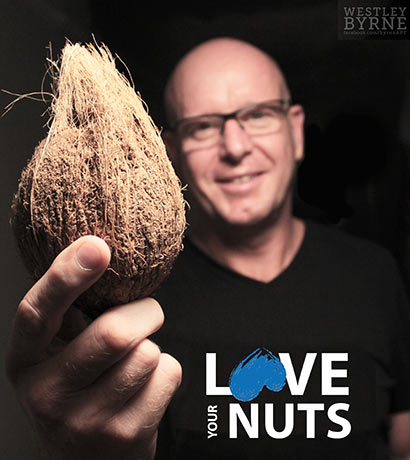Health: Have you loved your nuts today?
 April is testicular cancer awareness month. Why should you care? Because it’s the most common cancer in men under the age of 45; most often affecting those between the ages of 15 and 38.
April is testicular cancer awareness month. Why should you care? Because it’s the most common cancer in men under the age of 45; most often affecting those between the ages of 15 and 38.
Despite being highly treatable if caught early, most men don’t know how to check their balls for this potentially deadly disease or rarely get around to it.
Torsten Koehler, CEO and Founder of the Love your Nuts campaign, was just 30-years-old when he was diagnosed with testicular cancer after he found a lump”down there” in 1995. Within a week he had one testicle removed.
“My world scattered into millions of pieces. I went through the whole programme: surgery, chemotherapy, depression, lost my zest for life,” he says.
Torsten resigned from his job as a teacher, went backpacking for two years and ended up publishing a book recounting his cancer journey; Love your Nuts – Testicular cancer touched my life.
Now, with his Love your Nuts awareness campaign he’s helping make men aware of the cancer and encouraging patients not to give up; with the aim of increasing the survival rate amongst South African’s male population.
Torsten says that this rarely spoken about cancer all too often remains undetected in young adults in South Africa due “to cultural taboos, stigmas and lack of knowledge about the subject”.
So, whether yours are bold and low-hanging or tight and discreet, remember to love your nuts. Here are Torsten’s tips and advice on beating testicular cancer:
How do I check?
Examine one testicle at a time. Use both hands to gently roll each testicle (with slight pressure) between your fingers. Place your thumbs over the top of your testicle, with the index and middle fingers of each hand behind the testicle, and then roll it between your fingers.
You should be able to feel the epididymis (the sperm-carrying tube), which feels soft, rope-like, and slightly tender to pressure, and is located at the top of the back part of each testicle. This is a normal lump.
Remember that one testicle (usually the right one) is slightly larger than the other for most guys — this is also normal.
When examining each testicle, feel for any lumps or bumps along the front or sides. Lumps may be as small as a piece of rice or a pea.

Torsten Koehler
When do I check?
It’s best to check during or right after a hot shower or bath. The scrotum is most relaxed then, which makes it easier to examine the testicles.
What do I look for?
- Look for lumps/ irregularities on the (normally smooth) surface of the testis.
- Swelling of the testis
- A “heavy feeling” in the testis
- Pain – advanced stage
How often should I do this?
Once a month
Does an irregularity always mean cancer?
No – other diseases/infections cause swelling and pain too.
I found something, now what? Can a GP assist or who do I go to?
If you notice any swelling, lumps, or changes in the size or colour of a testicle, or if you have any pain or achy areas in your groin, let your doctor know right away.
Lumps or swelling may not be cancer, but they should be checked by your doctor as soon as possible. Testicular cancer is almost always curable if it is caught and treated early.
What happens once cancer is confirmed?
Normally the affected testis will be removed immediately. Depending on the stage of the cancer, treatment may include chemotherapy.
Does the removal of one nut affect my sex life?
With only one nut left you can still have a normal sex life (and usually have children); hormone production is taken over by the one nut. (Some guys may need hormone treatment if the production is too low.) Chemotherapy can make you infertile; that’s why all men donate sperm before treatment – just in case.
For more information about the Love your Nuts awareness campaign check out their Facebook, Twitter, Instagram pages or website.
Leave a Reply